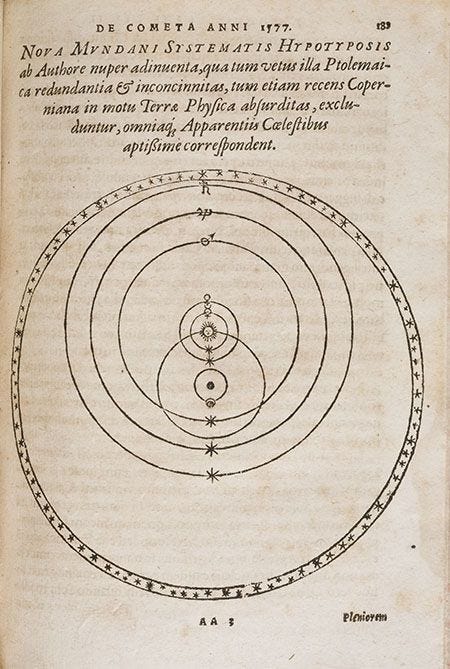The Creation of the World Astronomy/Astrology – Prequel to the Story of Atlantis

Plato and the Demiurge
In Plato’s Timaeus, Plato (through Timaeus) explains how the universe was created. Timaeus is the famous dialogue that describes how the Demiurge created the world and is the prequel to the story of Atlantis.
Plato was a smart guy, but he was around a long time ago…. was how he described the orbits of the planets correct? I think it was….
Plato says:
“And he gave dominion to the motion of the same and like, for that he left single and undivided; but the inner motion he divided in six places and made seven unequal circles having their intervals in ratios of two-and three, three of each, and bade the orbits proceed in a direction opposite to one another; and three [Sun, Mercury, Venus] he made to move with equal swiftness, and the remaining four [Moon, Saturn, Mars, Jupiter] to move with unequal swiftness to the three and to one another, but in due proportion”. Translated by Benjamin Jowett
And then….
“First, there was the moon in the orbit nearest the earth, and next the sun, in the second orbit above the earth; then came the morning star and the star sacred to Hermes, moving in orbits which have an equal swiftness with the sun, but in an opposite direction; and this is the reason why the sun and Hermes and Lucifer overtake and are overtaken by each other.
Plato only addressed the movements of Venus, Mercury and the Sun; to Plato these were primary and the movements of the outer planets were not discussed, being secondary.
To enumerate the places which he assigned to the other stars, and to give all the reasons why he assigned them, although a secondary matter, would give more trouble than the primary. These things at some future time, when we are at leisure, may have the consideration which they deserve, but not at present.”
So this description of the movements of the planets seems convoluted, incorrect and impossible. But it’s easily explained in the Tychonic and Tychos models (the modernized Tychonic model) and looking at the diagram of the models, it’s easy to see.
Plato ends up describing three very clear motions; the sidereal and synodic movements of Venus, Sun and Mercury. He also says that they move in opposite directions, which are retrograde.
- When planets move in opposite directions they are moving in a retrograde.
- Sidereal movements are movements of the planets measured against the stars. A prominent star is chosen, for example Regulus in the Leo constellation, and the planet is watched it until it returns to the same star.
- A synodic movement is when a planet starts at the Sun and returns to meet up with the Sun again.

So how do Mercury and Venus move with equal swifteness, but also overtake and are overtaken by each other and the Sun? And also move in the opposite direction?
Let’s talk first about the sidereal motion. In the Tychos model, Simon proves they are moving in equal swiftness by showing the average sidereal period of Mercury is one year1. To come up with this average sidereal length he watched (in an epheremis) how long it took for Mercury to return to Asellus Australis, a fixed star in the Cancer constellation. He noticed that Mercury had a seven-year pattern; 6 years when Mercury returned to the star in less than a year and then one year when it took 50 days longer than a year. Then the same seven-year pattern would repeat. The average over two of those seven-year periods is one year (365 days). This is easy to check in any epheremis.
Then he demonstrates the conjunctions of Mercury and Venus with the Sun as they revolve around the Sun, retrograde and move from closer or farther away from Earth is what results in the dance of the planets overtaking each other. This is the synodic motion. In the case of Mercury, this period is 116.88 days2.
The Timaeus Dialogue is about the cyclical disasters that occur during the Great Year and interestingly, Plato also mentions (through the character of Timeaus) that over the Great Year (or what is often referred to as the Precession of the Equinox), these planets will arrive back at the very same place. Incidentally, this is also something that is demonstrated in the Tychos and can be seen in the Tychosium as Earth moves in its own orbit… But I’ll save that for another post!
The Greeks had a conception of the world called the Thema Mundi. It’s a mythological chart that describes the world’s theme. It starts with Moon, then Sun, Mercury, Venus, Sun, Mars, Jupiter and Saturn (or Cancer, Leo, Virgo, Libra, Scorpio, Saggiturus and Capricorn – the signs of the planets in the same respective order).

Some have been confused about why Plato would confuse this order in Timeaus, seemingly switching Venus and Mercury back and forth. In Tycho Brahe’s Model (the precursor to the Tychos), Brahe shows the same order via glyphs and puts stars where the planets can be as they travel in their course… the addition of the stars adds the order of Aquarius (Saturn), Pisces (Jupiter), Aries (Mars), Taurus (Venus) and Gemini (Mercury) to complete the Zodiac.
The most important point relative to Plato/Timeaus is that the position of Venus and Mercury switch positions… there they are overtaken by each other and the Sun depending on whether they are one side of the Sun or the other. In the Tychonic and Tychos, it is easy to see! The Sun carries Venus and Mercury with it as it moves around Earth. Venus and Mercury overtake the Sun from Earth’s perspective, depending on where they are in their cycle with the Sun and each other.
So Plato did know what he was talking about! Maybe the Ancients knew more than we give them credit for!
I talk more about the order of the planets that Plato and others described in my upcoming book The Path is the Way, where I look at the planetary spheres as a spiritual path. Get notified when the book is available here.
